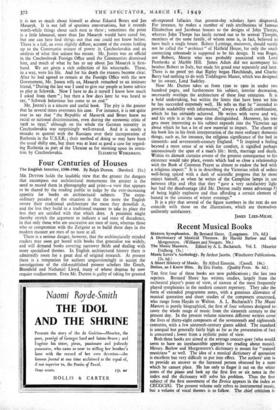Four Centuries of Houses
The English Interior, 1500-1900. By Ralph Dutton. (Batsford. 21s.)
Ma. DurroN holds the laudable view that the greater the dangers that encompass our architectural monuments the greater is the need to record them in photography and print—a view that appears to be shared by the reading public to judge by the ever-increasing appetite for books on architectural subjects. The extra- ordinary paradox of the situation is that the more the English revere their traditional architecture the more they demolish it, and the less they build in a traditional manner to take its place the less they are satisfied with that which does. A pessimist might thereby stretch the argument to indicate a sad state of decadence, in that only those who are uncreative are men of taste, whereas those who so compromise with the Zeitgeist as to build these days in the modern manner are men of no taste at all.
There is a serious danger, however, that the architecturally minded readers may soon get bored with books that generalise too widely, and will demand books covering narrower fields and dealing with more specialised themes. In English architectural history there is admittedly room for a great deal of original research. At present there is a temptation for authors unquestioningly to accept the investigations of the old-established pioneer scholars like Gotch, Blomfield and Nathaniel Lloyd, many of whose dogmas by now require readjustment. Even Mr. Dutton is guilty of taking for granted,
oft-repeated fallacies that present-day scholars have disproved. For instance, he makes a number of rash attributions of famous
Elizabethan and Jacobean houses to the designs of John Thorpe, whereas John Thorpe has lately turned out to be several Thorpes, members of the same family, of whom none is, in fact, believed to have built a single house. Robert Lyminge, moreover, should surely not be called the "architect" of Hatfield House, for only the south connecting colonnade is supposed to be his design. It. was Roger, not Robert, Morris who was probably associated with Lord Pembroke at -Marble Hill. James Adam did not accompany his brother Robert to Italy, but made his grand tour separately and later. There is no proof yet that Ripley began Hatch/ands, and Charles Barry had nothing to do with Toddington Manor, which was designed by its owner, Lord Sudeley.
Now Mr. Dutton takes us from 15oo to 19oo in under two hundred pages, and furthermore his subject, interior decoration, necessarily overlaps the architecture of these four centuries. It is a bold undertaking, but within the limits that have keen "set him he has succeeded extremely well. He tells us that he " intended to provide readability with information," always a difficult combination, which he has certainly- achieved. He writes with verve and wit, and his style is at the same time distinguished.. Moreover, his text gets more interesting as his subject expands into the Victorian age about which he has a lot of new material to impart. The charm of his book lies in his fresh interpretation. of the most ordinary domestic things, such as, for instance, the religious significance of the bed in sixteenth- and seventeenth-century England. " It inspired a feeling beyond a mere sense of or wish for comfort, it signified perhaps unconsciously the span of a man's • life : birth, marriage and death. Within its damask curtains events of, the greatest consequence to his existence would take place, events which had so close a relationship with the Book of Common Prayer as almost to endow the bed with a religious import." It is in describing the Victorian relish of sedate well-being, spiced with a dash of scientific progress that he most enjoys himself, as when he writes of the Camphine lamPi in use between 1830 and 1850 that they " gave a very satisfactory light but had the disadvantage (did Mr. Dutton really mean advantage ?) of being highly explosive and thus affording a certain element of hazard to the cosiness of winter evenings." It is a pity that several of the figure numbers in the text do not coincide with those on the illustrations, which are themselves uniformly satisfactory.
JAMES LEES-MILNE.






































 Previous page
Previous page